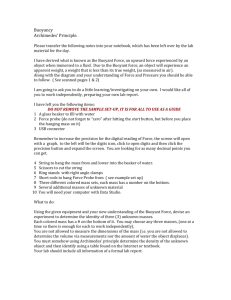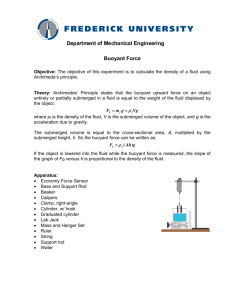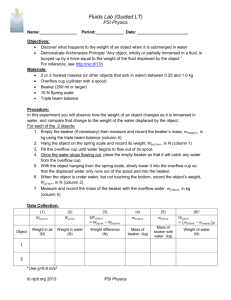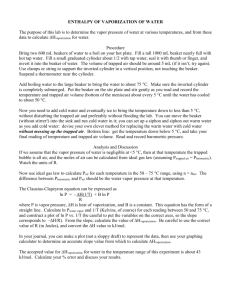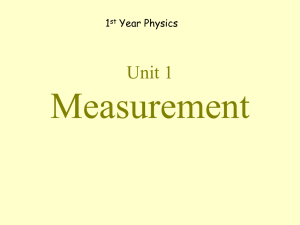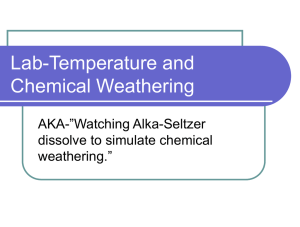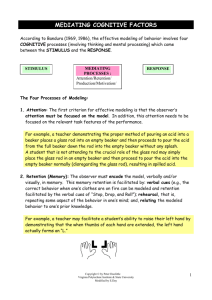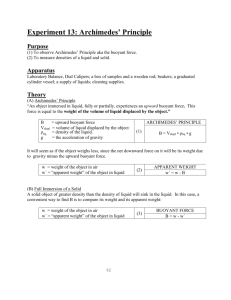AP Physics Lab – Buoyancy (and Density)
advertisement
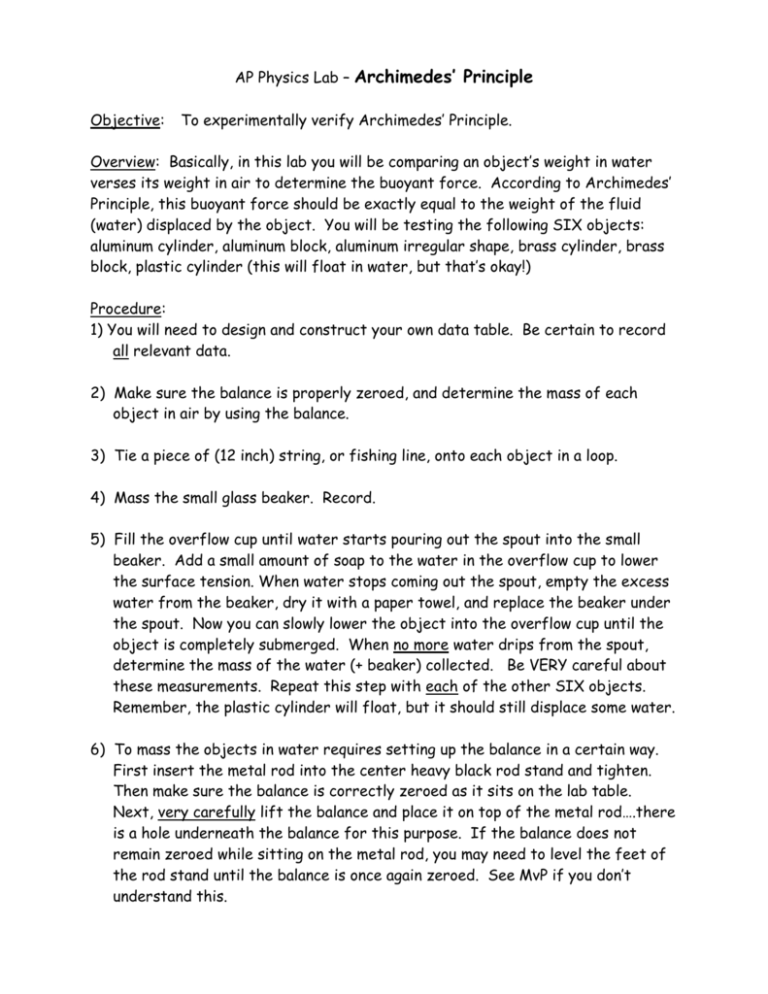
AP Physics Lab – Archimedes’ Principle Objective: To experimentally verify Archimedes’ Principle. Overview: Basically, in this lab you will be comparing an object’s weight in water verses its weight in air to determine the buoyant force. According to Archimedes’ Principle, this buoyant force should be exactly equal to the weight of the fluid (water) displaced by the object. You will be testing the following SIX objects: aluminum cylinder, aluminum block, aluminum irregular shape, brass cylinder, brass block, plastic cylinder (this will float in water, but that’s okay!) Procedure: 1) You will need to design and construct your own data table. Be certain to record all relevant data. 2) Make sure the balance is properly zeroed, and determine the mass of each object in air by using the balance. 3) Tie a piece of (12 inch) string, or fishing line, onto each object in a loop. 4) Mass the small glass beaker. Record. 5) Fill the overflow cup until water starts pouring out the spout into the small beaker. Add a small amount of soap to the water in the overflow cup to lower the surface tension. When water stops coming out the spout, empty the excess water from the beaker, dry it with a paper towel, and replace the beaker under the spout. Now you can slowly lower the object into the overflow cup until the object is completely submerged. When no more water drips from the spout, determine the mass of the water (+ beaker) collected. Be VERY careful about these measurements. Repeat this step with each of the other SIX objects. Remember, the plastic cylinder will float, but it should still displace some water. 6) To mass the objects in water requires setting up the balance in a certain way. First insert the metal rod into the center heavy black rod stand and tighten. Then make sure the balance is correctly zeroed as it sits on the lab table. Next, very carefully lift the balance and place it on top of the metal rod….there is a hole underneath the balance for this purpose. If the balance does not remain zeroed while sitting on the metal rod, you may need to level the feet of the rod stand until the balance is once again zeroed. See MvP if you don’t understand this. 7) To mass an object in water, you will need to hang the object from a pin underneath the balance using a piece of string (fishing line). Hanging a bent paper clip over the pin can save a lot of tying and untying knots. You have to be very careful about which pin you hang the paper clip onto. The pin you want is the small check pin located directly underneath the balance pan that runs perpendicular to the length of the balance. Ask MvP if you are not 100% certain about how to do this. WHEN YOU ADD THE PAPER CLIP, YOU MUST THEN REMEMBER TO RE-ZERO THE BALANCE! Once the object is hanging from the paper clip, you can then take the large beaker with water in it and hold the beaker carefully and steadily under and around the object so that it is submerged in the water, BUT NOT TOUCHING THE BEAKER BOTTOM OR SIDES. Now, carefully mass the object while it is in the water. 8) Determine the volume of each object by measuring its dimensions with a vernier caliper and calculating the volume. For the irregular piece of aluminum, you can determine its volume using the method of water displacement with the overflow cup, beaker, and a graduated cylinder. Note: do not use the beaker to read the volume! Instead pour the collected water into the more precise graduated cylinder. Now, using SI UNITS, calculate the weight of each object in air, weight in water, the buoyant force by subtracting the two weights, the buoyant force by using the formula FB Vg , and the weight of the displaced water. Calculate the percent difference between the buoyant force found by subtracting the two weights and the weight of the water displaced.
